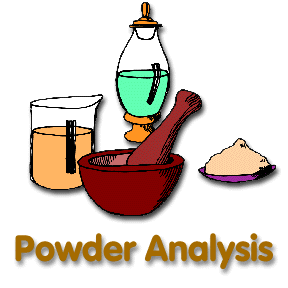

|
WHAT IS THAT
WHITE POWDER?
A forensic scientist may discover powder at a crime scene. In order to determine if it is illegal or not the crime lab will identify the substance using chemistry. Take on the role of a forensic chemist to identify unknown substances.
Complete the appearance, texture, and smell activities before opening the vinegar and iodine bottles.
Comparing test results of substances that are known help Forensic Scientists identify unknown substances. Try this in your classroom: After analyzing and recording results of each substance have your partner leave the area. Select and place one of the powders on construction paper and do not tell which substance it is. Invite your partner back to see if she/he can determine the powder by performing the same experiments and observations previously done. Change places so your partner can select one of the powders for you to identify. Can you correctly identify the mystery powder? Extension: View the powders under a microscope. |
Materials Lists
Resource: Detective Science: 40 Crime-Solving, Case-Breaking, Crook-Catching Activities for Kids by Jim Wiese
|
|||||||||||||||||||||||||||||||||||||||||||||||||
|
|||||||||||||||||||||||||||||||||||||||||||||||||||
© 1996 - 2011 Linda C. Joseph
All Rights Reserved
All CyberBee Graphics are Trademarked
Graphics by
Darlene Vanasco/Creative Director
Erika Taguchi/Designer & Illustrator
Hosting Provided by Iwaynet










